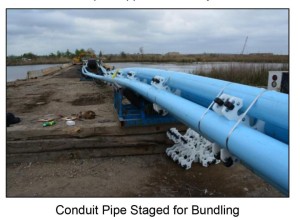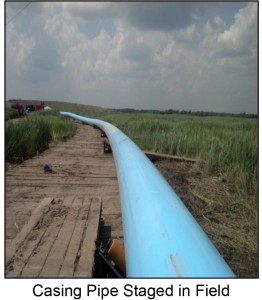Competitive Power Ventures’ Woodbridge Energy Center is a new, 700-megawatt, gas-fired power generating station currently being built in Woodbridge, New Jersey. When plant construction is complete, power generated by this new facility will be transmitted to an existing substation three miles away. Because the high voltage transmission lines cross two wetland areas and the Raritan River, use of traditional installation methods such as overhead towers and direct burial in conduit were not feasible in these sections of the alignment. In these three locations, horizontal directional drilling (HDD) was used to install more than 11,000 feet of 30-inch Fusible PVC® casing pipe. Each of the three sections required dual parallel crossings, resulting in six separate drills of casing pipe to house three 230 (kV) electrical
power generating station currently being built in Woodbridge, New Jersey. When plant construction is complete, power generated by this new facility will be transmitted to an existing substation three miles away. Because the high voltage transmission lines cross two wetland areas and the Raritan River, use of traditional installation methods such as overhead towers and direct burial in conduit were not feasible in these sections of the alignment. In these three locations, horizontal directional drilling (HDD) was used to install more than 11,000 feet of 30-inch Fusible PVC® casing pipe. Each of the three sections required dual parallel crossings, resulting in six separate drills of casing pipe to house three 230 (kV) electrical
cables each – conducting enough electricity to power more than 600,000
homes.
The configuration of the conduit bundles and casing spacers was designed by
Carson Corporation and Underground Devices, Inc. Each 30-inch Fusible
PVC® casing housed four 8-inch Fusible PVC® conduits to carry three 230 (kV)
cables (one spare conduit is for future use), two 2-inch conduits for ground and
fiber optic lines, and a 3-inch grout delivery tube. The 8-inch Fusible PVC®
conduits were de-beaded by Underground Solutions, Inc. using pneumatic debeading
equipment. The bundles were pulled into the 30-inch casings using a
small drill rig typically used for drilling fiber optic lines in neighborhoods. The
entire assembly was grouted using an engineered thermal grout for heat
dissipation. Finally, the 230 (kV) cables were pulled inside the 8-inch Fusible PVC® electrical conduits.
Drilling company, Carson Corporation, considered multiple casing and conduit pipe
materials, including steel and HDPE, before selecting Fusible PVC® pipe for the project.
Carson’s Vice President of Engineering, Scott Murray, calculated the pull-forces for
the various pipe materials and determined that Fusible PVC® pipe’s 7,000 psi tensile
strength was best suited for the project.
The internal and external diameters of Fusible PVC® pipe were also critical to selecting the casing and conduit material. The 30-inch pipe used for the casings needed to have the largest possible inside diameter to house the conduit bundles, while having the smallest possible external diameter to minimize the size of the HDD borehole. Likewise, the conduit pipe needed to have sufficient internal diameter to allow proper clearance for the power cables while having a small enough external diameter to fit within the casing. In addition, the 8-inch conduit pipe needed sufficient hoop strength to withstand external loading placed on the pipe during the grouting process.
Fusible PVC® pipe’s superior tensile strength and internal/external diameters provided the ideal material properties while offering significant project cost savings to the client. A non-metallic casing pipe also minimized ampacity loss across the HDD sections. Fusible PVC® pipe was connected to the open-cut conduit with standard power industry couplings and fittings, further simplifying the project.
Underground Solutions (UGSI) provides infrastructure technologies for water/wastewater applications. UGSI’s Fusible PVC® products, including Fusible C-900®, Fusible C-905® and FPVC®, contain a patented PVC formulation that, when combined with UGSI’s patented
fusion process, results in a monolithic, fully-restrained, gasket-free, leak-free piping system. UGSI’s Duraliner™ is a patented, close-fit pipeline renewal system creating a stand-alone structural liner.
